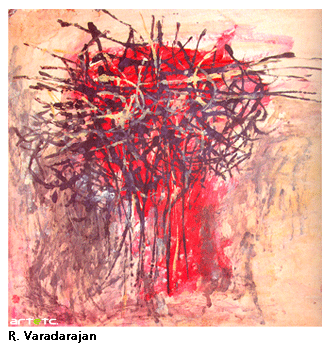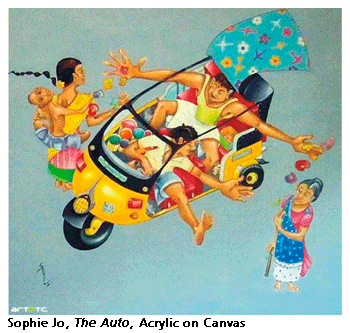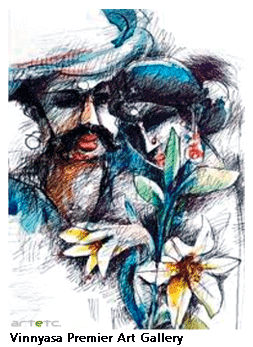- Publisher's Note
- Editorial
- Jogen Chowdhury: Maestro par Excellence
- Company School Paintings of Calcutta, Murshidabad, Patna (1750-1850): Doctoral Thesis of Late Dipak Bhattacharya (1960-2007)
- Kalighat Pat, a Protomodern Art Tradition?
- Academic Naturalism in Art of Bengal: The First Phase of Modernity
- Under the Banyan Tree - The Woodcut Prints of 19th Century Calcutta
- The Arabian Nights and the Web of Stories
- Gaganendranath Tagore's Satirical Drawings and Caricatures
- Gaganendranath's Moments with Cubism: Anxiety of Influence
- Abanindranath as Teacher: Many Moods, Some Recollections
- Atul Bose: A Short Evaluation
- J.P. Gangooly: Landscapes on Canvas
- Defined by Absence: Hemen Majumdar's Women
- Indra Dugar: A Profile of a Painter
- The Discreet Charm of Fluid Lines!
- Delightful Dots and Dazzling Environments: Kusama's Obsessive Neurosis
- Peaceful be Your Return O Lovely Bird, from Warm Lands Back to My Window
- Shunya: A Beginning from a Point of Neutrality
- The Tagore Phenomenon, Revisited
- The Bowl, Flat and Dynamic Architecture of the BMW Museum
- Baccarat Paperweights: Handmade to Perfection
- Byzantium and Islam: Age of Transition at the Metropolitan Museum of Art
- Outstanding Egyptian Art at the Metropolitan Museum of Art
- Retrospective of Wu Guanzhong at the Asia Society Museum
- Masterpieces from India's Late Mughal Period at the Asia Society Museum
- The Dhaka Art Summit: Emergence of Experimental Art Forms
- Many Moods of Eberhard Havekost
- Random Strokes
- Is it Putin or the Whole Russian State?
- The Onus Lies With Young India
- What Happened and What's Forthcoming
- Preview May, 2012 – June, 2012
- In the News, May 2012
- Art Events Kolkata, April – May 2012
- Mumbai Art Sighting
- Delhi Dias
- Art Bengaluru
- Musings from Chennai
- Cover
ART news & views
Musings from Chennai
Issue No: 29 Month: 6 Year: 2012
by Vaishnavi Ramanathan

In Chennai, like in many other Indian cities, there is a dearth of studio spaces. Especially when the medium is printmaking or ceramics, which requires specific infrastructure, the lack of studio spaces becomes a deterrent for artists in choosing a medium. A recent initiative in addressing this issue is the setting up of a ceramics centre at Dakshina Chitra. The ceramics centre includes studio spaces furnished with kilns that could be hired by artists at very nominal charges. For those new to the medium, guidance is also offered by ceramist S. Potrarasan. The ceramics centre is the first of the studio and residency facilities that Dakshina Chitra is planning to set up in the near future.

Ashvita Arts hosted a retrospective of senior artist and teacher R. Varadarajan's paintings, sketches and collages. One may perhaps say that his works generally tended towards the non-figurative, wherein even when human forms were depicted there seemed to be the desire to erase their presence by not depicting the head, blindfolding the eyes or making them merge with the background. The medium played an important role in his works since the imagery differed depending on his choice of medium. However, irrespective of the medium, the line was the primary element in his work reflecting the sensibilities of the Madras Art Movement. Rhythm was an important aspect of his work while the overall emphasis was on creating a mood.

N. Gurunathan and Sucheta Ghadge had displayed Time Circle, a site specific collaborative work at Lalit Kala Akademi. Both the artists are known for their work with organic forms and Time Circle was another step in the exploration of this imagery but through a new materiality created by stitching textured organic motifs on cloth. Hung on the wall of Lalit Kala Akademi, the cloth was like a mobile clock mapping the passage of time through the movement of shadows falling on the wall/cloth. The fallen leaves on the ground and the shadows of the trees playing across the cloth created a layered work that drew parallels between the body, the garment and the cycle of life and death.

Apparao Galleries presented the works of French artist Sophie Jo and Delhi based artist and architect Gautam Bhatia. The exhibition was a study in contrasts since Sophie Jo's paintings presented typical Indian scenes such as groups of people, farmers with cell phones, bike riders etc. The aerial close up view that emphasised the animated faces and the play of pastel colours created a fairy tale view of the reality that viewers were familiar with. In contrast were Gautam Bhatia's satirical political sculptures that did not let the viewer forget the seamier side of this fairy tale. Gautam Bhatia's paunch bellied babus and figures floating in a tar like sludge, created using a variety of materials, emphasised the hollow character of the political figures. The visual language of his works was direct and relatively devoid of metaphors.

Apart from this, Vinnyasa Premier Gallery had its Affordable Art show while Focus Gallery had a summer show displaying the works of artists such as Laxma Goud, Achuthan Kudallur, M.F. Hussain, K.S. Radhakrishnan, Redappa Naidu, Mark Rathinaraj etc.